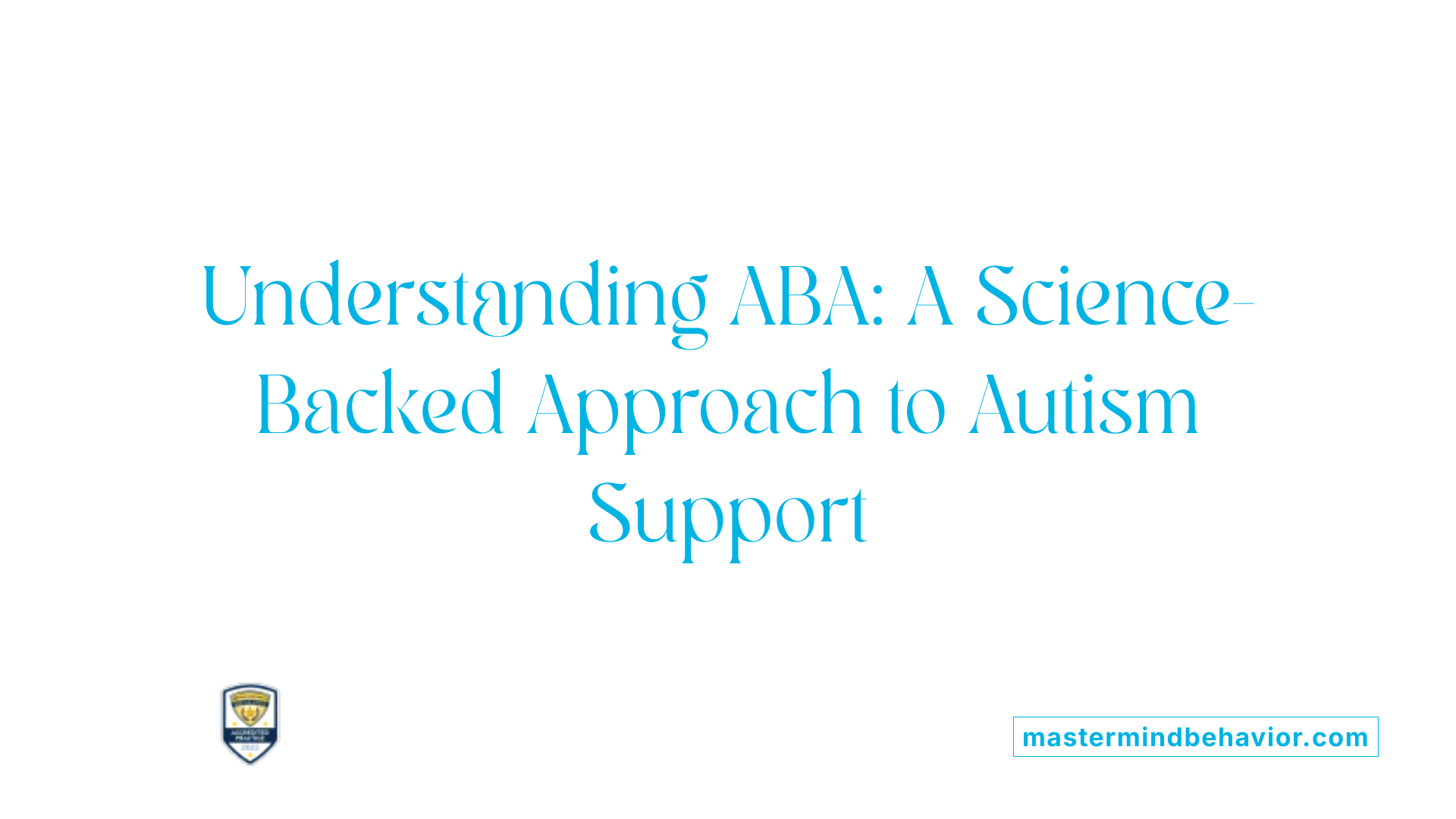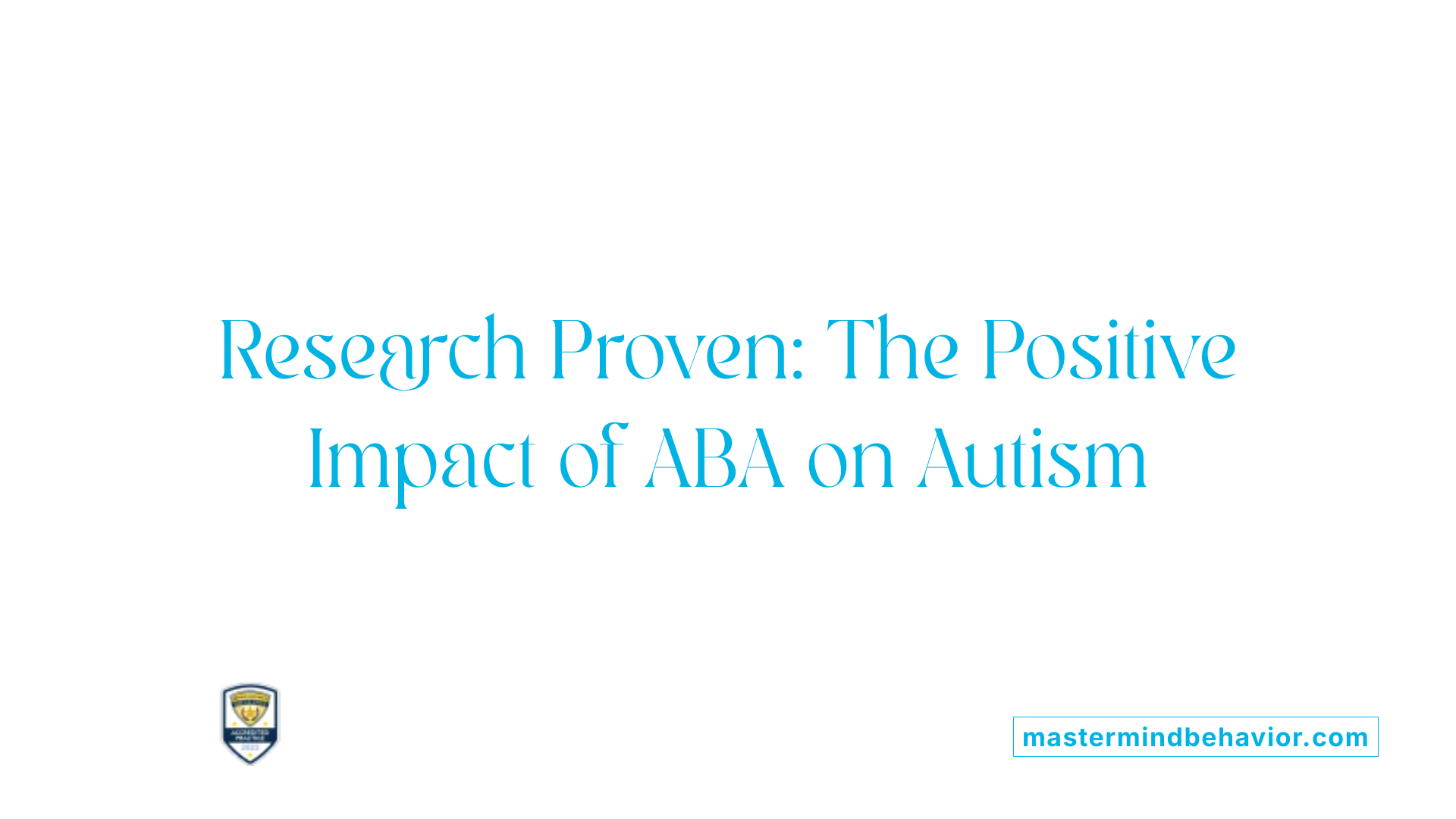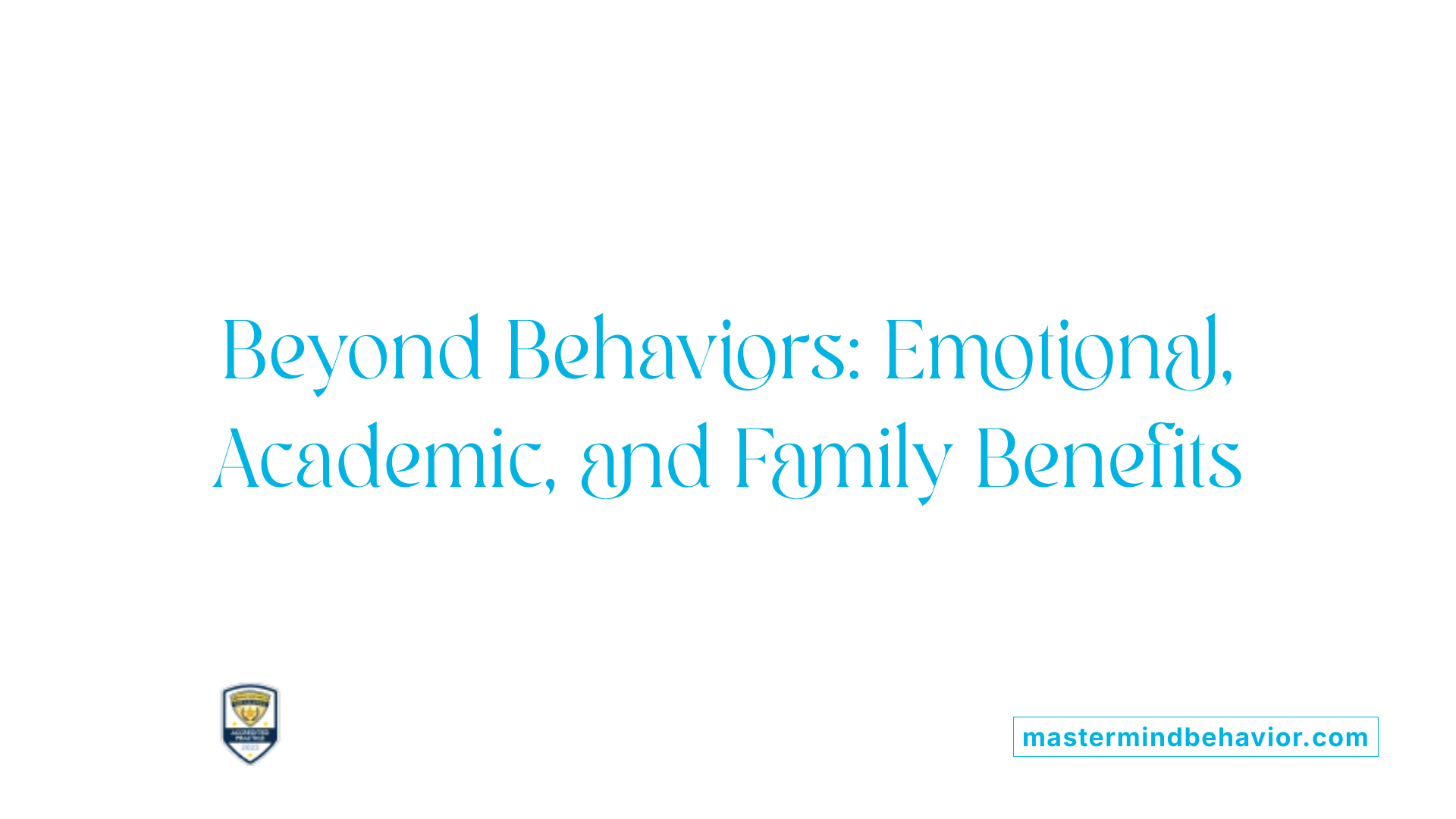Understanding the Power of ABA Therapy in Autism
Applied Behavior Analysis (ABA) therapy stands as a cornerstone intervention for individuals with autism spectrum disorder (ASD), particularly in addressing inflexible behavior patterns. These behaviors often pose significant challenges in social interactions, learning, and everyday functioning. This article explores how ABA therapy systematically reduces these rigid behaviors, fostering flexibility and independence through evidence-based strategies tailored to each individual's unique needs.
What is ABA Therapy and Its Role in Autism Support?

What is Applied Behavior Analysis (ABA) therapy, and how is it used to support individuals with autism?
Applied Behavior Analysis (ABA) therapy is a science-based intervention focused on improving specific behaviors and skills in individuals with autism spectrum disorder (ASD). ABA uses systematic, personalized techniques that promote helpful behaviors—such as communication, social skills, and daily living abilities—while reducing challenging or harmful behaviors.
The therapy relies on behaviorist principles, applying strategies like positive reinforcement and careful analysis of antecedents and consequences to shape behavior. This data-driven approach breaks down complex skills into manageable steps, making learning accessible and effective for each child.
ABA interventions are flexible and can be adapted to multiple settings, including home, school, and community environments. Treatment plans are tailored to individual needs and are developed and overseen by qualified professionals such as Board Certified Behavior Analysts (BCBAs), ensuring evidence-based care.
Sessions often involve play-based and naturalistic methods to keep children engaged. Progress is continuously monitored using data collection and ongoing evaluation to refine treatment plans. Through these efforts, ABA therapy supports the development of communication, social abilities, academic success, self-regulation, and independence.
In summary, ABA therapy is a well-established, effective approach that empowers children with autism to acquire meaningful skills and enhances their participation and autonomy in daily life.
Who Provides ABA Therapy and Their Qualifications

Who typically provides ABA therapy, and what qualifications do these professionals have?
ABA therapy is delivered by a team of trained professionals, primarily Board Certified Behavior Analysts (BCBAs) and Registered Behavior Technicians (RBTs).
BCBAs possess advanced qualifications including graduate degrees in behavior analysis or related fields. They achieve certification through the Behavior Analyst Certification Board (BACB), which confirms their expertise in designing, implementing, and supervising individualized treatment plans. These analysts ensure the therapy is evidence-based, ethical, and tailored to each child's needs.
RBTs support BCBAs by directly implementing the behavior intervention plans. They complete specialized training programs and must pass a competency assessment to become certified. While RBTs focus mainly on hands-on delivery, their work is closely supervised by BCBAs to maintain treatment fidelity.
Together, these professionals utilize behavior science principles such as positive reinforcement and task analysis to encourage desirable behaviors and reduce challenging ones. Their combined qualifications and structured training ensure effective, individualized ABA therapy for children with autism spectrum disorder.
Mechanisms by Which ABA Therapy Reduces Inflexible Behavior Patterns

What are Functional Behavior Assessments?
Functional behavior assessments (FBAs) are the starting point in ABA therapy for addressing inflexible or challenging behaviors. Therapists observe and analyze the circumstances that trigger these behaviors and the outcomes that maintain them. This detailed understanding allows for the creation of tailored interventions that address the root causes rather than just the symptoms.
How Does Positive Reinforcement Work in ABA?
Positive reinforcement involves rewarding desired behaviors to increase their frequency. In the context of inflexible behaviors, when a child demonstrates flexibility or uses alternative, appropriate behaviors, they receive immediate and meaningful reinforcement. This method helps gradually replace rigid or problematic behaviors with adaptive ones.
What Are Behavior Intervention Plans?
Following the assessment, individualized behavior intervention plans (BIPs) are developed. These plans outline specific strategies to reduce inflexible behaviors and promote positive skills. BIPs systematically guide therapists and families on consistent responses, ensuring the child learns more adaptive ways to cope and interact.
How Does Task Analysis Help?
Task analysis breaks down complex skills or routines into smaller, manageable steps. Teaching each component sequentially makes learning less overwhelming for children with autism. This stepwise approach encourages flexibility by enabling children to master tasks progressively, reducing frustration that might lead to rigid behaviors.
Together, these ABA mechanisms form a cohesive and evidence-backed strategy to reduce inflexible behavior patterns. By understanding the "why" behind behaviors and systematically teaching new skills reinforced with positive feedback, children with autism can achieve greater behavioral flexibility and improved daily functioning.
Behavioral and Developmental Benefits of ABA Therapy

How does ABA therapy benefit individuals with autism in terms of behavioral and developmental improvement?
ABA therapy offers substantial benefits by fostering improvements in communication, social skills, behavior, and independence for children with autism spectrum disorder (ASD). This evidence-based approach uses structured techniques like positive reinforcement to teach children various skills important for their growth and daily functioning.
Improvements in communication
ABA therapy enhances communication by teaching children to express themselves more effectively. This includes spoken language, sign language, or augmentative and alternative communication (AAC). Through individualized strategies, children learn to communicate their needs and feelings clearly, which contributes greatly to their overall development.
Enhancement of social skills
Social interactions improve as ABA therapy guides children to recognize social cues, share, take turns, and respond appropriately in social contexts. These learned behaviors help children feel more connected and comfortable in social environments, supporting better relationships and integration.
Reduction of challenging behaviors
ABA focuses on decreasing challenging behaviors such as tantrums, aggression, and self-injury. This is achieved by conducting functional assessments and crafting personalized behavior intervention plans that help children replace these behaviors with positive alternatives.
Development of daily living skills and independence
The therapy promotes independence by teaching essential life skills like dressing, feeding, toileting, and other self-care activities. By breaking complex tasks into manageable steps, children gain more autonomy, which enhances their confidence and quality of life.
Table: Overview of Behavioral and Developmental Benefits
| Benefit Area | Description | Impact on Child and Family |
|---|---|---|
| Communication Skills | Teaching expressive and receptive language | Better self-expression and understanding |
| Social Skills | Learning social cues, sharing, and turn-taking | Improved peer interactions and social comfort |
| Challenging Behaviors | Reducing tantrums, aggression, self-injury | Safer environment and reduced stress |
| Daily Living Skills & Independence | Fostering autonomy with self-care activities | Enhanced independence and family quality of life |
ABA therapy is tailored to each child's unique needs, ensuring that interventions are effective and meaningful. Its focus on observable behaviors and consistent reinforcement drives lasting developmental growth and improved quality of life for children with autism and their families.
The Role of Family and Caregivers in ABA Therapy Success

What role do families and caregivers play in the success of ABA therapy?
Families and caregivers are fundamental to the effectiveness of ABA therapy for children with autism. Their active involvement helps to reinforce the skills taught during therapy sessions, ensuring these skills are practiced and maintained beyond clinical settings. This ongoing support encourages the generalization of learned behaviors across home, school, and community environments, which is essential for meaningful and lasting progress.
Family involvement in therapy
Including families in therapy planning and decision-making creates a collaborative atmosphere. It gives caregivers a deeper understanding of ABA principles and builds their confidence in assisting with daily practice. Through consistent reinforcement of communication, social skills, and behavior management strategies developed during ABA sessions, families help sustain and enhance the child’s gains.
Parent training and skills reinforcement
ABA programs often offer parent training to equip caregivers with the techniques needed to effectively implement interventions at home. This training covers behavior management, teaching new skills, and responding to challenges. Such skill-building broadens therapy’s impact and empowers families to be proactive partners in their child’s development.
Impact on family stress and quality of life
ABA therapy has been shown to reduce parental stress by providing structure and visible progress in the child’s abilities. As families witness improvements in communication and social interactions, their quality of life increases, fostering a more positive family environment. Support resources tailored to caregiver needs also help address stressors connected to raising a child with ASD.
Generalization of skills across settings
One core goal of involving families is to promote the generalization of learned skills. Since behaviors often differ between environments, caregiver participation ensures that children apply communication, social, and adaptive skills consistently. This cross-setting practice is crucial for children to navigate real-life situations independently and successfully.
Evidence Supporting ABA Therapy’s Effectiveness in Autism

What Do Research Studies Reveal About ABA Outcomes?
Numerous studies have highlighted ABA therapy's positive impact on children with autism spectrum disorder (ASD). One notable study involved 100 boys aged between 4 and 11 years living in institutional care. Sixty participants received individualized ABA sessions twice a week over six weeks, each session lasting one hour. These sessions focused on improving social, communicative, and adaptive behaviors.
How Does ABA Improve Social and Adaptive Behaviors?
Data collected using tools like the Kindergarten Inventory of Social/Emotional Tendencies (KIST) demonstrated meaningful improvements post-intervention. Children exhibited enhanced social skills such as sharing and turn-taking, better communication abilities including expression via spoken language or sign language, and increased adaptive behaviors such as managing separation anxiety and daily routines.
What Statistical Evidence Supports These Changes?
The study employed a multivariate analysis of covariance (MANCOVA), which revealed statistically significant improvements (p < .05) in the intervention group compared to controls. This indicates that changes in behavior and emotional regulation were unlikely due to chance, affirming the effectiveness of ABA in fostering positive behavioral adaptations.
What Are The Long-Term Impacts Of ABA Therapy?
ABA therapy is designed not just for immediate gains but for sustained progress. Its comprehensive approach—incorporating individualized treatment planning, continuous assessment, and family involvement—facilitates long-lasting improvements in communication, social interaction, and independence. By reducing challenging behaviors and teaching self-regulation strategies, ABA helps children with autism build foundations for ongoing developmental success and enhanced quality of life.
These findings collectively underscore the well-established role of ABA as an evidence-based intervention that fosters meaningful growth in children with ASD across multiple domains.
Core Principles Guiding ABA Therapy

What Are the Applied, Behavioral, and Analytic Principles in ABA Therapy?
ABA therapy is grounded in three foundational principles. It is Applied because it focuses on behaviors that are socially significant and important for the child’s daily functioning. The Behavioral aspect emphasizes observable and measurable behaviors, rather than internal thoughts or feelings. Lastly, the Analytic principle means that interventions are data-driven and demonstrate clear cause-and-effect relationships.
How Do Technological and Conceptually Systematic Approaches Shape ABA?
ABA therapy employs a Technological approach by describing procedures in precise detail, enabling consistent replication by other therapists. The Conceptually Systematic principle ensures that all interventions are based on established behavior-analytic theories, providing a coherent and unified framework.
In What Ways Does ABA Promote Effectiveness and Generalization?
An Effective intervention produces meaningful improvements in a child's life, supported by continuous data collection and analysis. Generalization is crucial, as skills learned in therapy are designed to extend across different settings and situations, helping children apply what they learn broadly.
How Is Data-Driven Decision Making Incorporated?
Data collection and ongoing evaluations form the backbone of ABA therapy. Therapists use structured assessments and continuous monitoring to tailor treatment plans, track progress, and make informed adjustments, ensuring the therapy meets each child’s evolving needs.
Addressing Common Misconceptions About ABA Therapy

Are there any common misconceptions about ABA therapy that the public should be aware of?
ABA therapy is often misunderstood, leading to several common misconceptions that can affect its perception. One major misunderstanding is that ABA is a rigid or punitive approach focused on suppressing behavior through punishment. In reality, modern ABA therapy is highly individualized and flexible. It emphasizes positive reinforcement, naturalistic teaching strategies, and encourages communication, socialization, and daily living skills rather than punishment.
Another myth is that ABA therapy aims to "cure" autism. This is not the case; instead, ABA's goal is to support individuals with autism by teaching functional skills, promoting independence, and enhancing their quality of life. It helps children express themselves better, improve social interactions, and regulate emotions without attempting to eliminate the core identity of autism.
ABA therapy is supported by rigorous scientific research and is ethically grounded. Certified professionals (Board Certified Behavior Analysts) closely tailor interventions to each child's unique needs, ensuring effective and compassionate care. This evidence-based approach improves communication, reduces challenging behaviors, and supports families, demonstrating a clear intent to empower rather than control.
In summary, while misconceptions persist, ABA is a supportive, ethical, and scientifically validated intervention designed to help individuals with autism thrive across multiple areas of life.
Tailoring ABA Therapy to Individual Needs and Progress

Personalized assessment and planning
ABA therapy begins with a thorough assessment to understand each child's unique strengths, challenges, and needs. Qualified professionals, such as Board Certified Behavior Analysts (BCBAs), develop individualized treatment plans that focus on targeted goals. This personalized approach ensures that therapy addresses specific communication, social, behavioral, and academic skills tailored to the child.
Data collection and evaluation
Data collection is an essential part of ABA therapy. Therapists systematically record behaviors and progress during sessions to monitor effectiveness. Regular evaluation allows for adjustments based on the child's development, reinforcing successful strategies and modifying those that are less effective. This evidence-based methodology guarantees that interventions are both effective and adaptable.
Adjusting therapy over time
ABA therapy is dynamic and evolves as the child grows and develops new skills. Treatment plans are regularly reviewed and updated to reflect the child’s changing needs, ensuring the therapy remains relevant and impactful. The duration of therapy varies widely but is guided by consistent progress assessments, with the flexibility to extend or adjust sessions accordingly.
Suitability across ages and settings
Although ABA therapy is especially beneficial when started early, typically around ages 2 to 3, it can be effectively adapted for children of all ages, including older individuals. It works in various settings—from home to school to institutional environments—and involves family participation to generalize skills across contexts. This flexibility makes ABA a versatile and comprehensive approach for lifelong support.
Holistic Impact of ABA Therapy Beyond Behavior

How does ABA therapy contribute to emotional regulation and coping skills?
ABA therapy supports emotional well-being by teaching children with autism self-regulation skills. Through tailored interventions, therapists help children recognize their emotional triggers and develop coping strategies to manage feelings like frustration or anxiety effectively. This focus reduces occurrences of emotional outbursts and fosters resilience.
What role does ABA therapy play in academic achievement?
ABA breaks down complex academic tasks into manageable steps, facilitating clearer learning paths for children with autism. It also assists in creating individualized education plans (IEPs) tailored to each child's unique needs, enhancing their ability to grasp and retain academic concepts. The structured nature of ABA ensures steady progress in school performance.
How does ABA therapy improve family quality of life?
Families benefit greatly from ABA through decreased parental stress and improved home dynamics. Parent training is an integral component, empowering caregivers with skills to reinforce learning and behavior management consistently. This collaborative approach leads to a more supportive environment, enhancing overall family well-being.
What are the safety considerations and side effects of ABA therapy?
ABA therapy is widely regarded as safe with minimal side effects when delivered by qualified professionals like Board Certified Behavior Analysts (BCBAs). Its data-driven and individualized nature ensures that interventions respect each child's pace and comfort, minimizing risks commonly associated with other intervention types.
| Aspect | Benefit | Description |
|---|---|---|
| Emotional Regulation | Improved coping skills | Teaching emotional trigger recognition and coping strategies |
| Academic Achievement | Enhanced learning outcomes | Task breakdown and tailored education plans |
| Family Quality of Life | Reduced stress and better home support | Parent training and involvement in therapy |
| Safety | Minimal side effects with qualified therapists | Data-driven, personalized, and carefully monitored interventions |
ABA Therapy: Cultivating Flexibility and Empowerment in Autism
ABA therapy remains a scientifically validated, compassionate approach that directly addresses the inflexible behavior patterns often associated with autism spectrum disorder. By employing structured assessments, individualized intervention plans, and evidence-based techniques, it not only reduces rigid and challenging behaviors but also promotes communication, social skills, independence, and emotional well-being. The active involvement of qualified professionals, combined with essential family participation, ensures that therapy extends beyond clinical settings and into daily life. As research continues to affirm its effectiveness, ABA therapy stands as a beacon of hope and practical support, empowering individuals with autism to embrace flexibility and fuller engagement with their communities.
References
- 7 Surprising Benefits of ABA Therapy for Kids You Need to ...
- The effectiveness of applied behavior analysis program ...
- How ABA Therapy is Transforming the Lives of Children with ...
- The Role of Caregiver Involvement in ABA Therapy
- Parent Involvement in ABA Therapy
- The Importance of Parental Involvement in ABA Therapy
- Applied Behavior Analysis (ABA)
- Applied Behavior Analysis (ABA)
- Applied Behavior Analysis (ABA)









